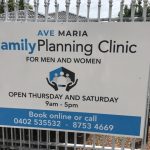Commentary on the
Public Health Amendment
(Safe Access to Reproductive Health Clinics) Bill 2018¹
Introduction
1. This document provides a concise critique of this Bill, which seeks to create a 150-meter ‘safe access zone’ around reproductive health clinics in this state which perform abortion, where three types of behavior within it will be illegal. These behaviors can be broadly summarized as impeding access to abortion clinics; making communications in relation to abortion that are reasonably likely to cause anxiety or distress to any person accessing, leaving or inside an abortion facility and, capturing or distributing visual data of people within the zone.
2. With its ambiguous language, the Bill has a potentially wide ambit of operation. It not only infringes the fundamental rights and freedoms of people to protest about abortion outside an abortion clinic and, potentially, to engage in political communication on this topic, but arguably extends to those maintaining a silent prayer vigil outside a clinic, or who stand outside clinics with information about options other than abortion in order to empower women to make an informed decision about their pregnancy. This Bill raises legitimate concerns, set out below.
The Public Health Act 2010 (NSW)
3. This Bill is the third attempt in two years to enact safe access zones in New South Wales, and is proceeded by the failure of the Summary Offences Amendment (Safe Access to Reproductive Health Clinics) Bill 2017 Act, and the Abortion Law Reform (Miscellaneous Acts Amendment) Bill 2016. Adopting a different tack to most other states,2 it utilizes the Public Health Act 2010 (NSW) which empowers the government to, amongst other things, make laws to promote, protect and improve public health and control risks to it.3 As public health laws may infringe individual rights and freedoms, the risks to health must be justified.
4. To qualify as a bona fide public health issue, as opposed to a law and order issue, Parliament should be satisfied that there is evidenced based research that can identify what activities occur outside abortion clinics in New South Wales, prove that these activities cause harm to women that can be differentiated from any harm consequent to undergoing abortion, and conclude that these activities represent a genuine public health risk that can only be controlled by the proposed insertion of these particular safe access zone laws.
1 Prepared by Lawyers Anna Walsh, Michael McAuley, and Michael Quinlan.
2 The Bill is drafted in similar terms to Part 9A of the Public Health and Wellbeing Act 2008 (Vic).
3 See Public Health Act 2010 (NSW) ss 3(1)(a),(b).
5. The objects of the Bill are to ensure that a person’s entitlement to access an abortion clinic is respected, and that their safety and wellbeing, privacy and dignity are protected when entering or leaving it.4 However the Bill appears to assume as a fact that the presence and activities of people outside abortion clinics in New South Wales are a source of harm to people entering. Justice and fairness demand that this assumption be scrutinized, and all stakeholders affected by this proposed law be invited to present their perspective.
6. Any stakeholder discussion must include groups who regularly organize prayer vigils and what is known as ‘side walk counselling’ outside abortion clinics in New South Wales, as well as local businesses that have observed activities over many years. Whilst it must also include people associated with abortion clinics, including employees and escorts who stand outside and accompany women into clinics, it must be acknowledged that clinic operators have a financial conflict of interest in ensuring that any activity that turns away clients is prohibited by law.
7. Whilst one must respect a person’s entitlement to enter an abortion clinic, unlawful abortion is still a crime in New South Wales, and doctors may be prosecuted.5 Operating as a principled exception under the Crimes Act, it is only lawful where a doctor has an honest belief that abortion is a proportionate response to a grave threat of harm to a woman’s life or health.6 Abortion is not ‘standard of care’ clinical practice, and a woman has no entitlement to demand a doctor perform abortion on her, just because she has provided informed consent.
8. The way in which the law characterizes abortion in New South Wales is very different to the way the law operates in Victoria, Tasmania, the Australian Capital Territory and the Northern Territory. These four jurisdictions have decriminalized abortion, regulate it under health legislation, and have enacted safe access zone laws outside abortion clinics.7 In those jurisdictions, abortion is ‘standard of care’ and women may demand abortion up to a specific gestational age, and doctors must assist them to achieve one, even if they have a conscientious objection to it.8
9. A democratic society permits the expression of different viewpoints on controversial or moral issues. If the state takes a particular position on such an issue in its law, it must not punish those who disagree with it, nor embed a presumption into other laws that the issue is resolved and everyone must agree. The claim that the expression of viewpoints causes harm to others is a novel proposition. Such an allegation must be supported by evidence with a metric for assessing harm that befits the notion of ‘public health’.
4 Clauses 98B(a)(b).
5 See, R v Sood [2006] NSWSC 1141 (31 October 2006).
6 See, Crimes Act 1900 (NSW) s81-4; R v Wald [1971] 3 DCR (NSW) 25.
7 See generally, Abortion Law Reform Act 2008 (Vic) s4; Public Health and Wellbeing Act 2008 (Vic)
ss185A-E; Reproductive Health (Access to Terminations) Act 2013 (Tas) ss 4,9; Health Act 1993 (ACT)
ss80-83; Termination of Pregnancy Law Reform Act 2017 (NT), ss7, 14-6.
8 The Australian Capital Territory is an exception. Pursuant to section 84 of the Health Act 1993 (ACT),
health professionals have no obligation to carry out or assist with carrying out an abortion.
Interfering with access of persons to reproductive health clinics
10. Clause 98C of the Bill prohibits interference with persons accessing or leaving an abortion clinic within the zone.9 As it provides a non-exhaustive definition of interference that includes ‘harass, intimidate, beset, threaten, hinder, obstruct, or impede by any means’,10 these examples do not constrain the interpretation of this provision, and can lead to a wider application by the courts, especially if the assumption underlying the Bill, that people who participate in prayer vigils and sidewalk counseling cause mental harm to women, is assumed as a fact.
11. It is an offence under the Crimes Act for either an individual or a group of more than five or more persons, to use violence or intimidation to compel a person to refrain from undertaking a lawful activity.11 Under both the Crimes Act and the Summary Offences Act 1988 (NSW), it is an offence for a person to use threats of violence that leads a person of reasonable firmness to fear for their safety.12 Under the Summary Offences Act, it is an offence to impede the free passage of a person in a public place,13 and police have wide powers to control unruly protests.14
12. All of these offences are capable of capturing genuine harassment and interference with people trying to enter abortion clinics. If Police have received complaints about the behavior of people outside abortion clinics, these should be considered carefully, with notice taken as to whether it resulted in a fine or conviction and whether it involves the same person or group. It seems clear that the above offences do not cover silent prayer vigils and respectful sidewalk counseling and that the Bill seeks to elevate to a crime, currently lawful behavior.
13. Penalties for breaches of this Bill are severe and disproportionate. Under the Public Health Act, a non-medical doctor tattooing someone’s eyeball,15 or a person who knows they have a notifiable disease or scheduled medical condition and fails to take reasonable precautions against spreading it,16 is penalized 50 units ($5,500) or imprisoned for six months or both. Despite the lack of parity between these offences and breaches under the Bill, the Bill applies the same penalty for a first offence, and doubles the penalties for a second offence.17
9 Clause 98C(2).
10 Clause 98C(1).
11 Crimes Act 1900 (NSW), ss545B, C(1).
12 Crimes Act 1900 (NSW), s93C(1); Summary Offences Act 1988 (NSW) s11A(1).
13 Summary Offences Act 1988 (NSW) s6.
14 See, eg, Law Enforcement (Powers and Responsibilities Act 2002 (NSW), ss 4(2), 87MA, 197, 198A.
15 Public Health Act 2010 (NSW), s39A.
16 Public Health Act 2010 (NSW), s79.
17 See Clauses 98C(3), 98D(1), 98E(1),(2).
14. Penalties under the Bill can also be contrasted with those under the Anti-Discrimination Act 1977 (NSW). The legislation provides for a criminal offence for inciting hatred, contempt or severe ridicule towards a person or group on the grounds of race by threatening physical harm towards people or their property, or inciting others to threaten such harm,18 however only serious behaviors of this type carry the maximum penalty of a $10,000 fine, or six months imprisonment for an individual. This differentiation in severity is absent from the Bill.
Causing actual or potential distress or anxiety to persons in a safe access zone
15. Clause 98D of the Bill is most worrying. This is because the language is wide and prohibits ‘communication that relates to abortion’, by any means, in a manner able to be seen or heard by a person entering or leaving an abortion clinic, that is reasonably likely to cause distress or anxiety to any such person. Setting a very low bar, the heading to the section, which may be used to assist in interpreting ambiguous wording in a section, notes that the communication need only cause ‘potential’ distress or anxiety. Absurd results will follow.
16. What ‘communication’ about abortion does not have the potential to cause anxiety or distress to someone entering or leaving an abortion clinic? Not measured against a standard such as the ‘reasonable person’, the potential impact on a sensitive person who hears or sees a communication about abortion is sufficient to conclude that a crime has been committed. A plain reading of the text of Clause 98D covers the sensitive person’s overhearing of a communication not meant for them. This is an extreme and unjustified violation of freedom of speech.
17. Family or friends accompanying women into or out of abortion clinics would be unable to discuss abortion when in the zone. As bizarre as this may sound, it is a real consequence of the Bill as currently drafted. People walking past the clinic and wearing apparel that associates them with a pro-life view would be engaging in criminal behavior. So too would pregnancy counseling services situated within the zone that have signage, such as Sarah’s Place in Surry Hills.19 Supporters of the Bill must clarify what they mean and consider appropriate amendments.
18. The Bill permits an exception in Clause 98D(2) for prohibited communication expressed by clinic employees. The cleaner employed by the abortion clinic, therefore, may talk about abortion in the zone and cause potential anxiety of distress to someone entering or leaving the clinic. The lack of logic in providing a blanket exception for clinic employees displays an absurd presumption in the Bill; that only people employed by an abortion clinic can be trusted to say the ‘right’ things about abortion, that does not cause harm to a woman’s health.
18 Australian Human Rights Commission, “Racial Vilification Law in Australia,”
https://www.humanrights.gov.au/publications/racial-vilification-law-australia.
19 Free standing pregnancy counseling services do not meet the exception set out in Clause 98F of the Bill,
which extends to churches or other buildings ordinarily used for religious worship.
19. Copied from Part 9A of the Public Health and Wellbeing Act 2008 (Vic), and recently used by a Magistrate to successfully prosecute Ms. Kathy Clubb, an experienced side walk counselor standing within the safe access zone, there would not appear to be a need to produce a complainant that is injured.20 For the issuing of penalty notices, the decision as to whether or not the communication was in breach of the Public Health Act falls to the authorized officer, where it appears to them that the person has committed a penalty notice offence.21
20. There are a number of groups in New South Wales that organize regular prayer vigils which they distinguish from protesting or demonstrating, and which perform sidewalk counseling. Sidewalk counseling is an activity which informs women of choices other than abortion, and offers practical help and assistance to women who may feel that they have no other choice than to undergo abortion, and who are in great turmoil or distress when considering abortion as a viable option for their personal circumstances.22
21. For some women, abortion is not an exercise of free choice, but rather the product of coercion or domestic violence producing emotional sequelae including post abortion grief. In addition, the decision to undergo abortion may be made without knowledge of various organizations designed to support women in a decision to continue pregnancy, and who provide emotional, financial and medical support. There is a real question as to what level of information, support and referral, counselors at private abortion clinics give women who fall into this category.
22. Several women who have undergone abortion in private clinics without adequate counseling or information about options gave their testimonies at Parliament House in May 2018. If we are to truly ‘promote, protect and improve public health’, as the Public Health Act requires, there must by persuasive evidence that private abortion clinics do provide adequate internal counseling or make referrals, and that the community as a whole benefits from the criminalizing of sidewalk counseling on the basis that it causes more harm than help.
23. The conclusion that sidewalk counselors could never enhance a woman’s health because they lack formal medical training is unjustified. Many doctors concede that a standard medical degree does not enable them to assess the many complex reasons a woman may consider abortion, or to know where to refer them for help that encompasses social, legal and spiritual needs. Doctors and nurses are entitled to hold a positive opinion about the morality or health benefits of abortion, but they ought not assume that all patients considering abortion share those beliefs.
20 See, Edwards v Clubb (Decision of Magistrate L. Bazzani, Magistrate’s Court of Victoria, 6 October
2017, Case number G12298656).
21 Public Health Act 2010 (NSW), s 118(1).
22 In McCullen et al v Coakley, Attorney General of Massachusetts et al 573 US (2014), the United States
Supreme Court struck down safe access zone laws in Massachusetts and accepted evidence that a
significant number of women were assisted by sidewalk counsellors, and had chosen a different path.
24. The concept of inserting safe access zone laws into public health legislation arose from the failure of the Fertility Control Clinic in Melbourne to successfully sue the Melbourne City Council for failing to act on allegations of nuisance against a group of long time pro-life protesters outside their clinic.23 It is important to note that whilst the clinic had complained about the group for years, this was the first time they alleged the group’s activities were dangerous to health, something not specifically covered by the Public Health and Wellbeing Act (2008) at that time.24
25. Whilst the clinic adduced witness statements from people who alleged they observed the pro-life group engaged in harmful activities, the Council also adduced a letter from the group attesting to 300 ‘turn around’ women they had assisted over their long involvement in protesting, prayer vigils and sidewalk counseling. Ultimately, the Court did not rule on this evidence, and found in favor of the Council. Shortly thereafter, the government amended the Act to include safe access laws, and emphasized the findings of one research project for support.
26. That research project was a university student’s Masters thesis in which the student interviewed women entering this clinic and asked about how they felt seeing protesters outside it.25 Whilst not seeking to impugn the researcher’s findings, common sense supports the imprudence of extrapolating the results of a study of one clinic in Victoria, to all abortion clinics in New South Wales, as it assumes homogenous activity by protesters/counselors and reactions to them by women entering the clinic that cannot be sustained without further evidence.
27. Even if it were shown that complaints to the police had been made about a particular person outside a clinic in New South Wales, unless it led to a successful prosecution, where the person is legally represented and evidence is tested, such complaints should be given very little weight in this important discussion. Amending the Public Health Act in this manner sets a precedent for future amendments to it. A risk to public health must be supported by more than anecdotal stories and/or a desire to embed an ideology in the law.
The identification by the public of the location of safe access zones
28. Yet another concern with this Bill is both the size of the zone and the inability to clearly identify where these zones exist. Reproductive health clinics that offer maternal health and perform abortions, qualify as safe access zones. This must, therefore, include public and private hospitals that perform abortion, and could even extend to GP clinics in which doctors administer the drugs for medical abortion. Given the seriousness of the penalties, and the wide ambit of the communication offence discussed above, being able to identify the zone is vital.
23 Fertility Control Clinic v Melbourne City Council [2015] VSC 424 (26 August 2015).
24 Ibid [10].
25 The student found that 80% of respondents to her study self-reported anxiety or distress at the protesters.
Conclusions that may be reasonably drawn from this study regarding the participant’s ability to exclude other causative factors for anxiety and distress cannot be overlooked.
29. Whilst it can be argued that the point of the Bill is to ensure privacy, there is a serious imbalance against the interests of the common good if conversations that relate to abortion, a topic that is by its nature likely to cause anxiety or distress to some people, are criminal inside the zone. One way to redress this imbalance is to incorporate signage so people are aware they are entering a safe access zone and must not communicate by any means about abortion. Whilst this sounds extreme, this is only because the Bill itself is extreme in its scope.
30. It is not enough for supporters of the Bill to say that the Bill will not be used to prosecute law-abiding members of the community who happen to communicate about abortion in the zone, and are overheard by those entering or leaving an abortion clinic. They can give no assurance in this regard. Elsewhere the Bill makes exceptions. Therefore, the absence of an exception to ‘a person who has a reasonable excuse’ must either be poor drafting that must be amended, or a clear indication that Parliament seeks to interpret the provision harshly.
Capturing and distributing visual data of persons in safe access zones
31. The final offence proposed by the Bill is Clause 98E which concerns intentionally capturing and distributing visual data of persons in safe access zones without consent. There is an exception applied to security cameras operated by the clinic, or persons employed or contracted by the clinic or acting on behalf of a person operating a clinic if the data is provided to the operator of the clinic or the police, or police acting in the course of their duties.26 The captured data need not be distributed in order for a person to be guilty.27
32. Whilst the primary concern may be for the privacy of persons entering the clinic, it does nothing to protect or assist individuals or groups outside the clinic who wish to contest they are in breach of any offences or keep records of their activities in the event they are complained of, or prosecuted.28 It preferences the clinic, and those closely associated with it, at the expense of others, and fails to address the clinic’s financial interest that is impeded by the activity of sidewalk
counselors, who may succeed in turning away clients from the clinic.
33. Claims that anyone has intentionally used visual data to improperly identify others to ‘shame them’ should be carefully scrutinized. In 2015, pro-life supporters Dr. and Mrs. Roland Von Marburg received an apology and a substantial damages payment for defamation from abortion rights advocate, Dr. Pieter Mourik, who collected petitions against their activities outside the abortion clinic in Albury, and posted untrue and offensive photographs of the couple outside the clinic, that caused them great professional and personal damage.29
26 Clause 98E(3).
27 Clause 98E(1).
28 As there is no right to privacy when in public spaces, this proposed offence is novel and would create a precedent without proper consideration of its consequences on matters outside of abortion clinics.
29 Von Marburg v Aldred & Mourik [2015] VSC 467 (30 October 2015).
34. Reference to this case highlights the injustice of embedding into the law an assumption that only people closely associated with an abortion clinic can be trusted to take visual data in the zone. Security camera footage of businesses not classified as adjacent to or near an abortion clinic, could potentially be criminal activity unless they satisfy the requirement of a reasonable excuse. Whilst it can be argued that this will be easy, it highlights the absurd size of the zone and its impact on members of the public who have expressed no opinion on abortion.
Final Comment
35. This commentary has not dealt with freedom of speech and assembly, nor the implied freedom of political communication which has been found by the High Court to exist in the Commonwealth Constitution, and which requires Commonwealth, State and Territory laws and executive action to comply with the implied freedom. The High Court will decide the Clubb appeal this year, regarding whether Victoria’s safe access zone laws infringes this implied freedom of political communication. If successful, it will invalidate the Victorian law and raise issues about the validity of safe access zone laws operating in other states.30







